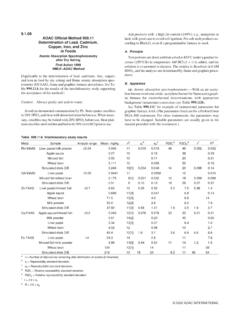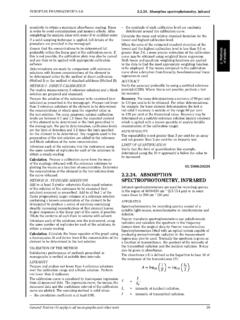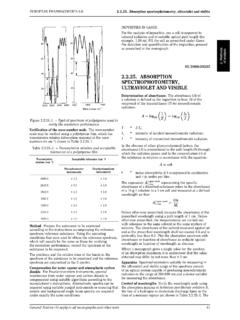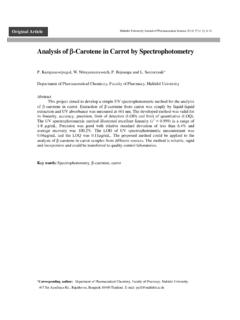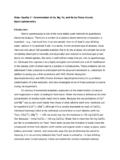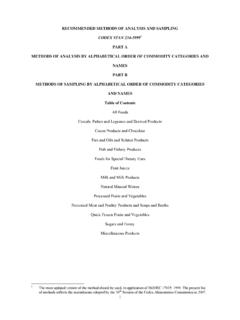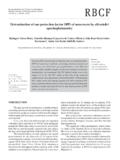Transcription of 9.1.08 40%. AOAC Official Method 999.10 Not applicable to ...
1 Official Method , Cadmium, Zinc, Copper, and Ironin FoodsAtomic Absorption Spectrophotometryafter Microwave DigestionFirst Action 1999 NMLK AOAC Method [ applicable to determination of Zn, Cu, and Fe in a variety of foodsby microwave digestion and flame atomic absorptionspectrophotometry (FAAS), and Cd and Pb by microwave digestionand graphite furnace atomic absorption spectroscopy (GFAAS). Method is capable of determining these elements at concentrationsabove approximately Pb ( ), Cd ( ), Zn (4), Cu ( ), and Fe (7)mg/kg. Method is not applicable to foods with a fat content 40%.Not applicable to milk the results ofthe interlaboratory study supporting the acceptance of the Method .]Caution: Digestion vessels must cool for an appropriate time be-fore opening in order to avoid burns from hot and cor-rosive vapors.
2 Always gently add acid to safe distance from furnaces equipped withZeeman background correction when the magnet is manufacturer s instructions to determine safedistance, which varies for different B, Laboratory Safety, for safe use of com-pressed gases, inorganic acids, and atomic absorptionspectrometer. For disposal of 4% acetic acid solutions,follow local regulations. 2002 AOAC INTERNATIONALT able Interlaboratory study resultsMetalSampleAnalyte range,mg/kgMean, mg/kgnaOutlierssrsRRSDr, % RSDR,%rRPb (GFAAS)Liver (GFAAS)Bovine muscle (FAAS)Fish (FAAS)Fish (FAAS)Fish Number of laboratories after outlier elimination. Values for sr, RSDr, and r are are only available for duplicate or split level diets E and PrincipleProducts are digested with HNO3and H2O2under pressure in a closedvessel heated by microwaves.
3 Solution is diluted with H2O. Pb and Cdare determined by GFAAS. Zn, Cu, and Fe are determined by Apparatus(a)Atomic absorption spectrophotometer. With air acetyleneburner or nitrous oxide acetylene burner for flame (FAAS; ) and a graphite furnace for electrothermal (GFAAS; ) determinations, with appropriate background(nonatomic) correction.(b)Hollow cathode or electrodeless discharge lamps. For Pb,Cd, Zn, Cu, and Fe.(c)Microwave oven. Designed for laboratory use, ,MDS-2000, CEM Corp., PO Box 200, Mattews, NC 28106-2000 USA. Microwave oven should be regularly checked for deliveredpower. If the measured effect does not agree with the specification,adjust the program: Fill a plastic beaker (polypropylene or Teflon)with kg water (room temperature) and measure temperature(Tb). Place beaker in microwave oven and heat water at full powerfor 2 min.
4 Take beaker out of oven, stir water, and measure tempera-ture (Ta). The delivered power in watts:P=35 (Ta Tb)(d)Teflon digestion vessels. 100 mL, withstanding a pressureof at least MPa.(e)Volumetric flasks. 25 and 1000 mL.(f)Funnels. Glass or plastic.(g)Plastic bottles. , Polystyrene bottles with tightly fittinglids, 50 100 mL.(h)Drying oven. Or equipment for glassware and plasticware should be carefully cleaned andrinsed, , with HNO3or HCl , in order to avoid metal ReagentsReagents should be of at least analytical reagent grade ( ), pref-erably ultrapure (suprapur) or equivalent.(a)Water. Redistilled or deionized, 18 M cm.(b)Nitric acid. 65% (w/w).(c)Nitric acid. Dilute 7 mL concentrated HNO3,(b),with water to 1 L.(d)Nitric acid. 3M. Dilute 200 mL concentrated HNO3,(b),with water to 1 L.
5 (e)Hydrogen peroxide. 30% (w/w).(f)Zinc standard solution. 1 mg/. Dissolve g Zn in 14 mLwater+7mLnitric acid, (b), in 1 L volumetric flask. Dilute to vol-ume with water. [Note: Commercially available standard solutionsfor AAS ( , BDH Chemicals Ltd., Poole, UK) may be used for allmetal standard solutions.](g)Copper standard solution. 1 mg/mL. Dissolve g Cuin 7 mL nitric acid, (b), in 1 L volumetric flask. Dilute to volumewith water.(h)Iron standard solution. 1 mg/mL. Dissolve g Fe in14 mL water+7mLnitric acid, (b), in 1 L volumetric flask. Dilute tovolume with water.(i)Lead standard solution. 1 mg/mLDissolve g Pb in7mLHNO3,(b), in 1 L volumetric flask and dilute to volume withwater.(j)Cadmium standard solution. 1 mg/mL. Dissolve mgCd in 14 mL water+7mLHNO3,(b), in 1 L volumetric flask and di-lute to volume with water.
6 (k)Working standard solutions. (1)For flame analysis. Di-lute standard, (f) (j), with ,(c), to a range of standardsthat covers the concentration of the element to be determined. (2)For graphite furnace analysis. Dilute standard solutions, (f) (j),with ,(c), to a range of standards that covers the linearrange of the element to be Procedures(a)Cleaning procedure. (1)For glass andplasticware. Acid solution: 500 mL concentrated HNO3,C(b), +4500 mL deionized water,C(a). Wash first with water and deter-gent. Rinse with tap water, followed by deionized water, then withacid solution. Finally rinse 4 5 times with deionized water. (2)ForTeflon digestion vessels. Rinse with acetone, wash with deionizedwater, keep vessels covered with ,C(c), for at least30 min, rinse with deionized water, and let vessels separate vessels for different applications, depending on theconcentration of metals.
7 If, however, the same digestion vessels areused for heavily contaminated products, , sludge, it may be nec-essary to use a more severe cleaning procedure, , heating vesselstogether with concentrated HNO3,C(b). The instrument manualusually provides detailed instructions for such cleaning procedures.(b)Pre-treatment. If product is to be analyzed fresh, proceed to(d), , continue at (c),Drying.(c)Drying. Dry to constant weight in drying oven at 105 C, orfreeze-dry. Freeze-drying is usually preferable because it renders theproduct less compact and easier to homogenize. If final result isbased on fresh weight, weigh test portion before and after drying toobtain water content:H2O= 100where H2O, % = water content of the test portion (%); Wf= weight ofthe test portion (g); Wd= weight after drying (g).
8 (d)Homogenization. Homogenize products usingnoncontaminating equipment. Check for leached metals if the appa-ratus consists of metal parts. 2002 AOAC INTERNATIONALT able Instrumental parameters for FAASM etalFlame typeWavelength, nmZnAir acetylene, acetylene, acetylene, acetylene, Instrumental parameters for GFAASM etalWavelength,nmTemperature ( C)/ramp-hold (s)Cleaningout step( C)Ashing step Atomization (e)Digestion. Weigh g dry material into digestion ves-sel. If water-containing materials are used, maximum weight is re-stricted to 2 g, but dry matter content must never exceed g. Forexample, if product has a water content of 50%, take a maximum of1 g (= g dry matter). If a product has a water content of 95%, take2 g (< g dry matter). When unknown products are digested, toomuch solids may cause the safety membrane in the digestion vesselto 5 mL HNO3,C(b), and 2 mL 30% H2O2,C(e).
9 Close vessels,place vessels in holder, place vessel holder in microwave oven, andclose door. Set oven program according to the parameters given inTable 3 and start program is valid only when 12 vessels are being digested si-multaneously. If fewer are being digested, the remaining vesselsmust be filled with reagent blank. When a microwave oven otherthan the one given as an example is used, it may be necessary to use aslightly different time/power digestion vessels from microwave oven and let cool thor-oughly before opening them. Open vessel and rinse down lid andwalls into container. Transfer solution to 25 mL volumetric flask anddilute to mark with deionized water. Then, transfer solution to plas-tic container. Treat blanks in the same way as tests. One blank shouldbe included in every set.
10 (f)Dilution. If test solution needs to be further diluted (due tohigh metal concentrations), dilute with 3 MHNO3,C(d), in order tomaintain same acid concentration prior to metal determination, (g).High acid concentration is environmentally undesirable and maydepress the analytical signal. Reduce acid strength by diluting thetest solution12with acid and standard solutions12with3 Mnitric acid. The tests and standards are thereby brought to thesame acid concentration. Matching of acid concentrations is impor-tant when a calibration curve is used.(g)Atomic absorption spectrophotometry . Use of flame orgraphite furnace technique is determined by the concentration of themetal to be determined. Flame technique should be used as far aspossible, since this technique is less sensitive to interference than theGFAAS.
